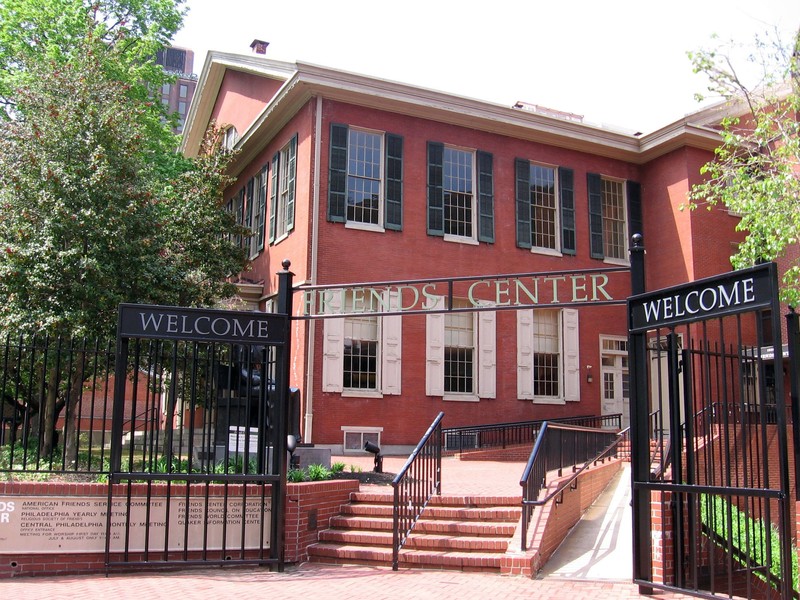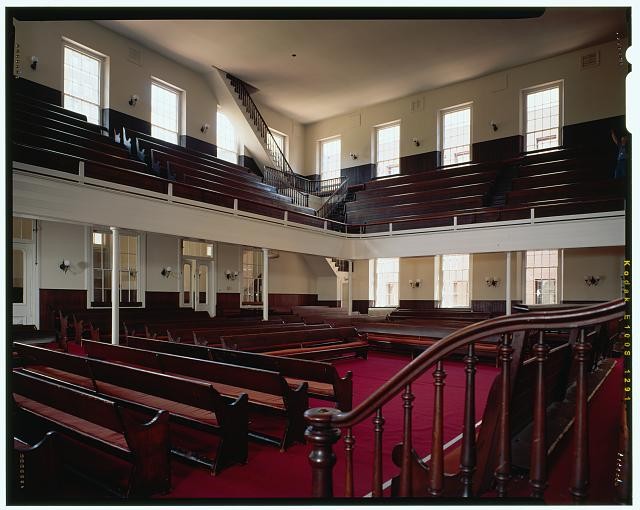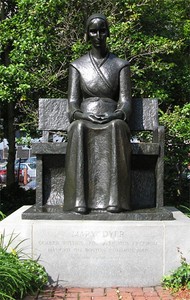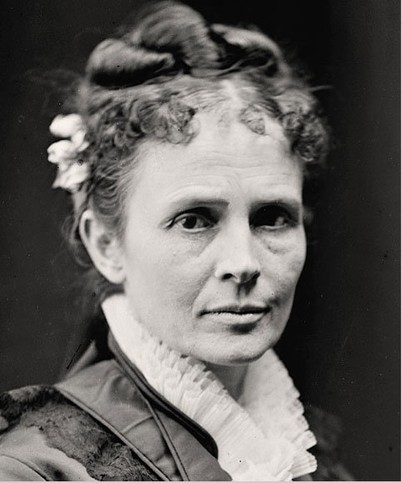Race Street Friends Meetinghouse
Introduction
Text-to-speech Audio
The Race Street Friends Meetinghouse, which was built in 1856, now, ironically, fronts Cherry Street. The site has been in continuous use by the Religious Society of Friends, or Quakers, for over 150 years. The site was converted into the Friends Meeting Center when a modern addition was built in 1975 while still maintaining the integrity of the original meetinghouse. The meetinghouse played a significant role in the social movements of both the 19th and 20th centuries, to include the abolition, women’s rights, temperance, peace and civil rights movements. And, not surprisingly to the Quakers, women, such as Lucretia Mott, Hannah Clothier Hull, Alice Paul and Jane Rushmore, who were associated with Race Street, led the way. Group tours are available by appointment and it was designated a National Historic Landmark in 1993.
Images
The entrance to the modern Race Street Friends Center. The meetinghouse, built in 1856, is on the left.

An aerial shot of the Friends Center. The large meetinghouse is on the left and the modern edition, camouflaged by its "green" roof, sits off the right.

The clean interior of the meetinghouse house to include the balcony or "youth galleries" that line three side of the spacious room.

The statue of Quaker martyr,Mary Dyer, that sits on the grounds of the Friends Center. A similar statue sits in Boston and also honors her devotion to her religious conscience.

Lucretia Mott (1793-1880) who was an ordained Quaker minister at Race Street and was also a leader of both the abolition and women's rights movements of the 19th century.

Backstory and Context
Text-to-speech Audio
The meetinghouse has served as the home to the Hicksite Sect of the Society of Friends since 1856. They have been in the Cherry Street area since they broke from the Arch Street Meeting house back in 1827 over ideological differences. That original Cherry Street meetinghouse no longer stands. However, the “Hicksites” as they were called, finally reconciled with the “orthodox” Quakers of Arch Street in 1955.
The house was originally divided into two meeting rooms as Quaker business meeting were segregated by gender until 1926. The south meeting room was then used for social gatherings and serves that function to this day. Both rooms are surrounded by balconies, or “youth galleries” on three sides. The meetinghouse is now part of the larger Friends Center Campus that includes national offices and the Greater Philadelphia Chapter of the United Nations Association. The campus was completely renovated in 2009 and designated a LEED Platinum site that is fossil-fuel free and produces zero carbon emissions. The modern addition now houses the offices of many non-profit organizations.
The meetinghouse gained its National Historic Landmark status due largely to the role women played in promoting and spreading various social movements beyond its boundaries. To that end, the Friends have added a statue of Quaker martyr, Mary Dyer, who was hung in Boston in 1660 in an attempt to overturn anti-Quaker laws adopted by the colony. Dyer represents a long tradition of female activism within the Society of Friends. Long before other religious denominations, the Quakers promoted female equality and women played key roles in the affairs of the church. They were, from the beginning, allowed to contribute during meetings and worship services on equal footing with men, and were ordained as Quaker ministers. These policies proved to many Quaker and non-Quaker women that they could also contribute to the larger society outside the confines of the meetinghouse.
One such woman was Lucretia Mott, who was quite active at the Race Street Meetinghouse and eventually became an ordained minister. She spoke and preached there on numerous occasions and went on to become a leading member of the abolitionist and women’s rights movements. She travelled to and spoke at various other meetinghouses, was a collaborator with William Lloyd Garrison, founded the Female Anti-Slavery Society and spoke at the Seneca Falls Convention on Women’s Rights in 1848. She was active until her death in 1880.
Sources
Mesirow, Jill. "National Register of Historic Places Nomination Form." United States Department of the Interior/National Parks Service. November 14, 1991. Accessed December 30, 2016. http://www.dot7.state.pa.us/CRGIS_Attachments/SiteResource/H053063_02J.pdf
Miller, Richmond. Race Street Meetinghouse, 1856-1956. Friends Historical Association. 1957. Accessed December 30, 2016. https://www.jstor.org/stable/41944623?seq=1#page_scan_tab_contents
"History of Friends Center." Friends Center Corp. Accessed December 30, 2016. http://www.friendscentercorp.org/?page_id=110
